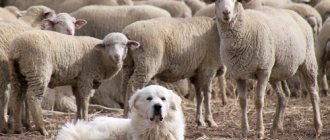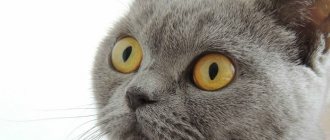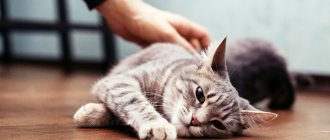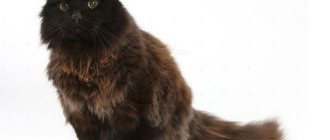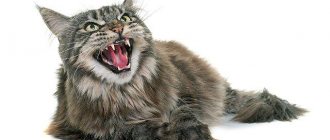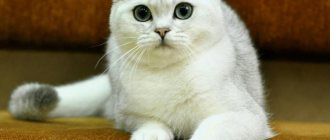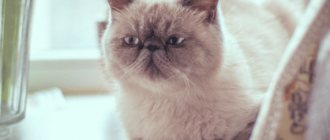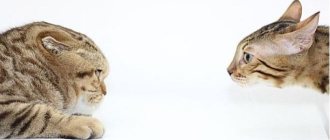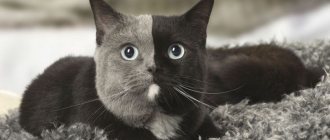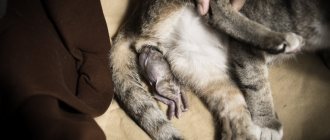The British are no strangers to aristocratic manners and self-sufficiency. Without any advertising or made-up stories, the British cat is truly popular. Worldly vanity is not for them. These cozy, important, personable, stocky cats are especially loved by respectable men, perhaps due to some similarities.
British cats look like women from high society: beautiful and inaccessible. They will not take well to intrusiveness from guests and even the owner. They perfectly express their love for their owner, while being at a distance from him. Therefore, you don’t have to worry that he will get very bored at home alone; most likely, he will even have a great rest without your presence.
British cat - plush joy
Description of the breed
The British Shorthair is a cat breed that was first registered in 1898. It is the result of selection of the Persian breed and the ancestors of wild cats, transported from France by settlers several centuries ago. These are wayward and independent animals, with the nature of an aristocrat, who will not contact strangers.
After several generations, the British Longhair appeared, which in June 1979 was registered by the international organization TICA. Today, the breed has already been recognized by many organizations and its representatives boldly exhibit at various exhibitions and receive awards, recognition, and popularity. These two breeds are similar to each other not only in character, but also in body structure.
Britons are loyal, loving animals who bond well with children, making them suitable for families with small children. They are playful, but not affectionate. If the family is large, they do not choose one person for friendship, but establish friendly relations with all members of the household.
This is a companion breed, but at the same time it should have time and personal space for privacy. They don’t like being picked up or kissed, so they will resist this in every possible way, pushing and turning away.
Main character traits of a British cat
Before you get a British breed kitten, you need to know that he is not as sociable as other felines. These animals are cold, restrained in emotions and allow themselves to be loved from afar. They accept affection if they are in a good mood.
Main character traits:
- If a child or a new animal appears in the house, the British take it seriously. He is jealous, so he needs attention. Ignoring it from the owner will cause the pet to become upset and begin to mope.
- The arrival of guests may make the cat unhappy, but she will never show it and will behave politely. First, she will sniff the stranger’s things, watch him, and only then will she develop a trusting attitude towards the guest.
- The cat is a housewife by nature and regularly walks around the house. If you close access to the rooms, she will start to get nervous.
- The animal’s behavior is also influenced by the emotional situation in the family. If there is peace and quiet in the house, the cat will behave well, but as soon as scandals and quarrels begin, its character will change dramatically. She will become nervous and will harm family members in every possible way, thus expressing protest.
- This is a touchy and stubborn feline breed. It is impossible to change your pet's mannerisms or force him to perform any actions. He will be offended, hide away from view, and may even bite, causing a wound to the owner.
Be sure to read:
Is it possible to cross a Briton and a Scot: why it is not recommended when mating is possible
How active and cheerful a cat is depends on its health.
Exterior of a cat
British cats have a strong body: powerful short llamas, a thick tail, slightly rounded at the end. Another special characteristic of the breed is its dense, plush coat that does not lie close to the body with a fine structure, as well as a round muzzle with large cheeks, and large bright orange eyes. The paws are round and small. The ears are wide and low set, small, slightly rounded at the tips.
Thick fur with a delicate undercoat, when you stroke or caress it, you get the feeling that you are touching a plush toy. Medium-sized animals with a large body and roundish paws with pink-coffee pads. There may be tufts of wool between the toes, and fluffy woolen trousers and a rich collar at the back. The tail is short, but incredibly bushy - when a cat gets angry and starts waving it, it looks like a huge fan.
The long-haired British breed is of short stature, but with a long body. They have a massive chest, a short neck and a large head with wide cheekbones. If you look closely at the face, it seems that the cat is smiling. The ears are slightly rounded and set wide apart. Eyes can be of different colors: yellow, closer to orange, blue and green.
What is noteworthy is that both animals in a pair must have the same eye color; you cannot cross cats of green-eyed representatives of the breed with blue-eyed cats or a cat with orange eyes.
The pads with whiskers near the small nose give the breed a certain charm; the British have massive whiskers, and the whiskers are long and stick out in lush bushes in different directions. Very cute creatures - it’s impossible not to love them, they are just soft little cuties. The weight of an adult cat is 5-7 kilograms, slightly smaller cats weigh about 4-5 kilograms.
Breed colors
According to the standard, the breed can have several colors, each of them beautiful and unusual in its own way. Most have a single color color - white, ash-blue with a bluish tint, cream shades, chocolate. Black and red long-haired cats look impressive; this color is unusual for the British, but at the same time interesting, and the mystery always causes demand and popularity.
This breed also comes in tortoiseshell and marbled colors. Smoky cats resemble chinchillas, they are also called smokes, cameos. What makes them special is the fact that their undercoat is white - a very attractive combination. The legs, head and back are in darker colors, and the belly and fluffy collar are lighter, sometimes almost white.
The tabby color deserves special attention - smoky with stripes slightly darker in color from the base. The chest and neck have continuous rings, and on the forehead of such cats the letter “M” clearly appears - the dark color of the coat grows in this way. The legs and lush hips are covered with circles - this is a feature of British tabbys with semi-long hair.
This breed also has bicolors, which combine the main color with white. In this case, the standard stipulates that white should not be more than 30% and this is mainly the breasts, neck, and belly.
It is unacceptable to have lightened tips on the coat, like representatives of the Russian Blue cat. The heavily bleached blue color prevents her from receiving the title. Despite its impressiveness, black color is considered the most problematic, since the presence of white hairs or brown spots is unacceptable. Chocolate color is considered both beautiful and complex.
It is worth noting that the fur coat of these animals is very complex. It consists of a two-level structure: a dense undercoat and guard hairs protruding above it. This feature creates the famous pearlescent sheen for kittens with a lilac or blue color.
The world of British cats originally from England is rich and attractive. They are charmingly showy and graceful, as if emphasizing their aristocratic origin.
The cutest cats in the world: the appearance of the British
The British cat is the embodiment of “blue blood”. When a person says “I have a purebred cat,” then most often we imagine an imposing British cat. Their appearance has become the ideal of feline beauty for millions of people: the breed is second in popularity only to the Scottish Fold.
Britons are quite large animals. Males weigh 5-8 kg, females about 4 kg. Pedigree characteristics are most clearly manifested in cats. Their silhouette looks squat (short, strong legs), and all shapes are soft and rounded. The tail is thick and short, with a rounded tip. Cats look very harmonious and proportional.
British silver chinchilla cat
A separate song can be dedicated to the head of British cats. Those cheeks! The head looks round no matter which way you look at it. A wide skull, a pronounced massive chin - the British cat personifies strength and solidity. Round, dense cheeks give the impression that the cat is constantly smiling into its whiskers.
The British have a recognizable head shape
The large round eyes of the British have a breed feature: a bright copper color. Exceptions are allowed for certain colors: silver cats will have green eyes, while pure white cats may have blue, yellow or different colored eyes. Cats of the so-called “Siamese color” (colorpoint) always have blue eyes.
British blue cat: bright copper eyes are magnificent
British cats of a certain color have an unusual phenomenon - eyes of different colors.
British bicolor cat with heterochromia
You can read about heterochromia and see more photos of different-eyed cats HERE (the link will open in a new tab).
We invite you to familiarize yourself with: Cornish Rex kittens, sale in Moscow
The fur coat of British cats is the pride of the breed, their signature feature. The short and dense coat looks plush and soft and is gentle to the touch. The secret is that the guard hair and undercoat of the British are the same length, no more than 2.4 cm, and the coat is very thick.
British color point cat
A British cat can have almost any color; to list all the color combinations would require a separate rather large article. In Russia, the most famous are the blue color, and after the advertisement of the famous cat food - the silver tabby, which is called the “Whiskas” color.
Next to a blue cat is a teenager of Whiskas color
Character and behavior
According to breeders, a British cat, like Maine Coons, is an ideal addition to a cozy and calm home. The main condition for the breed to be in the house should be psychological comfort and tranquility in the family, and living conditions do not bother them too much. They will fit perfectly in a small apartment or in a huge mansion. They are not prone to aggression, will find a common language with dogs, and will become a child’s best friend.
The British are calm. even somewhat lazy cats. They love to sleep in a cozy place and easily become attached to their owner. Kittens are very inquisitive and incredibly playful - they love to run after a ball, climb on racks, and tumble with each other. If they are interested in something or are bored, they will find something to entertain themselves with. They can throw a piece of candy, a hairpin, a pen, or something else into their teeth with their paw, which they will then play with. Kittens are quite easy to toilet train as they are smart and clean creatures.
Adult cats are the embodiment of calm and peacefulness. They calmly tolerate the absence of their owners at home, in some cases they may not even notice, since they slept all day. But when they hear the steps of the owners who come home, they always greet them and rub against their feet, putting their muzzle up to be stroked. British cats get along well with children; there are cases when they try to lie next to or in the arms of special children, as if sensing their weakness and insecurity.
They get along with other animals in the house or try not to notice them. They are even very friendly with dogs and cats, they make contact with them or bully them, trying to involve them in the game. They are inquisitive creatures, easy to train, and understand the character of their owners. They don’t like excessive attention to them, being carried in your arms, or being squeezed - they’d rather lie on the sidelines, but you can pet them anyway.
Their meowing is similar to some kind of hoarse chirping and they pronounce these sounds muffled and not loud. Each jump from a height is accompanied by this sound - it looks fun and funny.
Features of the British
- They lend themselves well to training and education. These smart animals can follow directions and remember up to 50 words.
- Although they are distinguished by a certain stubbornness, they carry out the owner’s commands accurately. In order for him to fully reveal his character to you, you need to respect his personality and find time to communicate.
- They react perfectly to the appearance of a new animal in the family, without fights or jealousy. They are not characterized by impulsiveness or aggression. They get along well not only with cats, but also with dogs, if they are compatible with each other in character.
- The Briton will be a wonderful friend for a person who is constantly at work, since the lack of communication does not negatively affect the animal.
- These are not tame pets; they would rather lie down close to you, or curl up in a ball, rather than lie in your arms.
- They will never do anything they don’t like and will not accept the annoying affection of their owners.
- When they are small, kittens love affection and ask to be held, but when they grow up, they prefer to keep their distance from their owners. Tenderness and affection in their understanding are manifested in mutual respect and strong emotional contact.
- Although they get along well with children, they may be offended if the child is overly active, so they may try not to show themselves to the children too much.
British cat. Character, reviews, advantages and disadvantages:
The main advantage is accuracy and cleanliness. The breed is very successful in this. In addition, licking calms the animal. If a cat is yelled at, it begins to wash itself to bring itself back to normal;
A cat won't do anything stupid unless provoked. So, if an animal poops in the wrong litter box, remember what you did wrong;
A Briton can easily sleep up to twenty hours . This is completely normal. There is no need to wake him up or take him to the vet. This is his daily routine. These cats surpassed even officials and deputies in their love for idleness and an idle lifestyle;
Pride does not allow this cat to ask . If she wants to eat, she won't meow. Rather, he will sit near the bowl and watch until the owner realizes that it is time to have lunch or dinner;
The British are stubborn. If they don’t want to do something, they won’t do it even under pain of being left without food. Do you need to sit hungry for two days for the owner to “get it”? No problem, he'll sit out. And you will feel guilty of all mortal sins;
Kittens living with a cat quickly adopt its skills. For example, go to the litter box, and not shit in the apartment;
Did you say "kitty kitty"? Sorry, but the British are above this, and only respond to the name;
And the character of British cats includes independence and strength. They are self-sufficient and easily tolerate loneliness. However, they are also capable of missing their owners. And even be offended by people for leaving for a long time;
Patience. This quality allows them to withstand the bullying of young children. Another breed may behave aggressively in such situations. The Briton will not use his claws without a clear reason or provocation from people.
Also, a plush British cat shows its character if its freedom of movement is limited. No need to close the doors. She needs to wander around the house. Don't worry about shoes and flowers. The animal is not interested in them. It will “mark” only its tray, and eat what is put in the bowl.
So the British cat breed has a truly aristocratic character. From cold arrogance to friendliness the path is short. And it lies through the trust and love that the cat requires. Whether you will be able to achieve favor depends only on yourself.
Some people say that these cats never claw or bite. It should be clarified that they do not do this without a clear reason. By nature, this breed is not at all aggressive.
Pros and cons of the breed
The character of the breed can be called universal; they can get along in any family. It is not difficult to care for them: play, feed them properly. They are a long-lived breed (they live up to 20 years), and always look young, perhaps because they mature only at 3 years.
Those wishing to acquire this breed of cat should remember that they will not lie on their owner’s lap for hours and demand affection. Quite the contrary, the British refuse to be cuddled, stroked or hugged.
It is also useless to train them, although some owners managed to get their pets to greet each other like dogs - the cat began to offer its paw.
British cats adapt both to indoor conditions and to living outdoors, for example, in the country. This breed is very active, so they should have enough space for games, various “climbing areas” so that the cat can jump and move around for pleasure.
Due to the fact that the ancestors of this breed are wild cats, they have excellent health and hunter habits, so they need to be outside as often as possible.
The period of sexual aggravation in the female is quite stormy, with meowing and mating games characteristic of many of their relatives. On average, a British woman gives birth to 4-7 kittens; cats have a well-developed maternal instinct. If a male lives with a cat in the same house, then he can equally take part in taking care of the babies - licking them, warming them with his warmth.
Relationship with the owner
A true Briton is smug and self-sufficient, and views his owners as breadwinners. It is not without reason that this breed is considered suitable for business people. They don't like to sit on their hands and can't stand noisy companies at all.
After a long day of work, the pet will greet the person reverently and tenderly, and will rub against the legs. They don’t like it when the owner stays late somewhere and doesn’t come home from work on time.
The short-haired British aristocrat purrs and purrs only to selected people. Plush pets guard their boundaries and get used only to those who feed and care for them. Only this person will have them sit on his lap.
If there is a child in the family, you should not have a Briton for his entertainment. Representatives of this breed are very patient with children, but they will not allow themselves to be made into toys. They will hide and run away.
It is very rare for a straight-eared Briton to be “tame.” He doesn't often ask to be held and petted. However, when he needs to climb onto his owner’s lap, he will follow along until he achieves his goal.
Care and maintenance of a British cat
Beautiful and thick hair is the wealth of British cats. Unlike Persians, their fur does not bunch up. To do this, it is enough to scratch them 1-2 times a week with a hard brush with rubber tips or a special mitten with teeth, which are available in every pet store or veterinary pharmacy.
During the molting period, you can carry out scratching procedures more often to help the cat renew its coat. This kind of care will help avoid having six throughout the house. Long-haired cats can also be cut or groomed. Modern pet salons offer a number of different services for cats; there is a catalog of hairstyles that can be done for cats and they will look attractive and well-groomed every time.
Since cats shed twice a year in autumn and spring, and their fur is very thick and the animals often lick themselves, it is advisable to give hair-removing drugs during this period. The procedure will help to gently remove hair from the cat’s body and avoid pain and clogging of the stomach and intestines.
Bathing is an activity that most felines dislike. If you are accustomed to the procedure from infancy, then in the future there will be no problems with bathing. You can wash the wool with a mild shampoo, but without fragrances and dyes, with a neutral pH. After the bath, wrap the cat in a soft towel and let the water soak in; do not try to rub, as this can lead to tangling of the fur.
Your pet’s claws also require careful care, as this breed is more susceptible to fungal diseases than others. The claws should not flake or peel, as this may be a signal of the presence of fungal diseases. It is enough to trim the nails once every 2 to 3 weeks. At least once every six months, the cat must be shown to the veterinarian.
With proper care, your furry pet will live up to 15-20 years, which is the average statistical life span for the British. Nature has given them a sharp mind, complaisance and equanimity - they calmly endure visits to the veterinarian, moving, and traveling.
Features of behavior and character of British women
In many ways, the characteristics of a British cat are determined by its behavior. A cat's character is formed before the age of one year, after which it is quite difficult and sometimes impossible to re-educate it. Sometimes a cat’s incorrect behavior is a consequence of lack of education in the early period.
- British cats will rarely ask a person for help or meow pitifully; they are usually used to figuring things out on their own. This also applies to the litter tray. Little kittens, watching their mother, begin to go to the toilet in a designated place. They are too clean and proud to shit on their feet.
- The British can sleep for a long time, unlike other breeds, they choose absolutely any sleeping position, especially touching the owner when the cat sleeps on its stomach. Some representatives of the breed can be in the arms of Morpheus for 20 hours! There is nothing scary about this, there is no need to panic and constantly wake the animal, otherwise it will become irritable, lose its appetite and desire to play.
- British owners will agree that these cats attach great importance to their appearance. They can lick themselves and wash themselves several times during the day. Many note that the British especially often perform this procedure after a quarrel with the owner, a trip, a meeting with a veterinarian, that is, in a stressful situation. Hygiene procedures calm the cat and restore its psychological balance and comfort.
Proper nutrition and menu for the British
British breed cats are massive, heavy individuals that require a special diet with a high protein content (up to 33 - 34%). In addition, their diet should contain a large amount of vitamins (biotin, calcium, microelements), possibly in the form of vitamin complexes (this way you will eliminate allergies). Representatives of this breed are not picky, so they can be fed both dry food and natural food, but under no circumstances mix these two food options.
To highlight the color of the animal, you can add vitamins with seaweed. After this, the red and tortoiseshell color will be brighter, the lilac color will receive a warmer, pink tone. Even the eyes will have a more intense color. If you give this supplement to cats of cream, blue-cream, or chinchilla color, the color will become darker. There are other foods that affect the color of an animal's fur: liver, carrots.
For example, a natural menu for an adult cat should consist of:
- boiled meat (turkey, lean beef, chicken, rabbit)
- not fatty sea fish;
- porridge (buckwheat, semolina, milk);
- cream.
If you want your cat to eat dry food, then your pet should eat only elite brands of food. For a small kitten, a feeding regimen of 4-5 times a day is necessary. For an adult cat – 2 – 3 times.
It is strictly not recommended to feed representatives of this breed with fatty meat, add spices, salt, smoked meats, poultry with bones, or feed fatty sea fish.
There is no need to overfeed the animal - this can cause obesity, especially since the British have a tendency to this disease. In the early stages, kittens prefer dairy products - cottage cheese, kefir, yoghurt. If you get a kitten that is accustomed to homemade food, then it is not necessary to retrain it to feed.
You can also add quail eggs, beef, veal to your cats’ diet, and you can also feed them a little boiled chicken. It is undesirable to give fish, fish heads and entrails - such food will not lead to anything good, and the bones can also get stuck in the throat.
British diseases
These cats are distinguished by excellent health and are considered a fairly hardy breed. But at the same time, there are diseases to which they are susceptible. This breed has two types of blood at once - A and B, which can cause problems if you decide to start breeding cats.
British Shorthair cats have about 36% type B blood. If they mate with type A cats, a litter of both types A and B may result. Kittens with type A blood are relatively healthy individuals, but die within 24 - 72 hours, which is called “disappearing kitten syndrome” and is explained by the presence of B antibodies, which are produced against type A. Antibodies can pass to the kitten with mother’s milk, where they fight the baby’s red blood cells and kill them.
Using a special DNA test, you can determine what type of blood a kitten has and avoid their death. Other diseases include: dental problems, tendency to be overweight, infectious diseases. The latter can be prevented by timely vaccination of the animal.
It is necessary to vaccinate the animal and give anthelmintic drugs in accordance with the schedule in order to avoid infection with various infectious diseases and parasites. The British by nature have excellent health and resistance to disease, but preventive procedures and regular examination by a veterinarian once a year are the minimum that every loving owner should do for their pet.
Buying a British kitten
The difficulty of choosing for the future owner can only be caused by the need to determine the color of the future pet, since there is definitely no shortage of nurseries in Russia. There are almost 300 of them, and each of them offers a wide selection of kittens of various colors.
You should wait to buy a kitten until it is 3-4 months old. Despite the external charm of all kittens, you should remember that British cats should not have skinny paws, giant ears, a long elongated nose and small, deep-set eyes.
Even if you saw a cat at an exhibition and fell in love with it, don’t rush into buying it. Visit a nursery, or better yet several. Look not only at the kittens, but also at their mothers.
It is important to find out the pedigree of a cat, because it is not just that you buy an expensive animal from a nursery; it must be possible to trace the ancestors of at least 4 generations.
Each ancestor must be identified by the abbreviation BRI, which stands for British Ring. From a good breeder you will always, without any questions, receive all the certificates about vaccinations, taking anti-worm medications, castrations/sterilizations, which will be stipulated in the clauses of the purchase and sale agreement, including participation in exhibitions.
It is easy to recognize a healthy kitten: it is active, playful and inquisitive. Play with the kitten, ask the breeder in more detail about its habits.
Cost of cats
The price is influenced by many indicators and, first of all, the presence of a pedigree and the status of the nursery. Depending on the different colors, the cost changes - if it is a rarer color, the kittens are sold more expensive, if it is a more common and less valuable color, the kittens are cheaper. Also, the price of cats is higher than the cost of males. Females are more often bought to have offspring or for their more docile nature.
Today in the nursery the cost of long-haired purebred cats with an impeccable pedigree ranges from 400 to 1400 dollars. If you don’t need a handsome purebred, then you can buy a mixed breed from home owners much cheaper. For example, if you buy a kitten second-hand, it will cost you 1,000 rubles.
History of the breed
The history of the breed stretches back centuries. More than 1000 years ago, back in 940, in every settlement in Wales for nine buildings there lived such an animal with certain inherent qualities. The price of such an animal was very high, they bought it with whole families, took great care of it, took care of it, created the best conditions, but also received enormous benefits in return! After all, the British saved entire settlements from the invasion of mice.
Sometimes it’s even hard to imagine how much they have changed over this millennium! The breed acquired its plump cheeks only in the 70s of the 20th century, presumably from mating with the Chartreux breed. The appearance was slightly adjusted, and large, wide-set Persian eyes were added to the appearance.
Gradually, the animal, which became a symbol of England and recognized by all philological organizations in the world, acquired its current appearance: a strong animal, with plump paws, a round muzzle and short thick hair.
The first person to pay due attention to the breed was the Englishman Harrison Weir (1824-1905). He became the first felinologist expert who made yesterday's mouse catchers into a breed popular throughout England by the beginning of the last century.
You can find various names for this breed until the 40s of the last century. The most sought-after cat was the blue cat, whose coat color ranged from a close-to-gray blue to a deep, dark shade. The First World War left its mark not only on people’s lives, but also brought cats of this breed to the brink of extinction.
After 1945, the year the Second World War ended, the breed had to be restored through crossings with other shorthair cats, as well as Persian, Russian Blue, Chartres and others.
It was impossible to avoid the undesirable features of other breeds that appeared in appearance (snub nose, soft coat, underbite). As time passed, these shortcomings were smoothed out, which led to the abandonment of outcrosses. The development of the breed was quite active, and by now a massive animal has formed, with large, heavy bones and round eyes.
The first representative of the breed entered the United States of America in 1901, however, the CFA recognized them as an independent breed only in 1950, and the first club in the country appeared more than 20 years later. The breed came to the Soviet Union from the territory of Germany (formerly the Federal Republic of Germany) in 1989-1991.
Cat breeds: British Shorthair
The British Shorthair cat is a squat, strong animal with a wide chest and has dense, short and very thick hair. Representatives of the breed are unpretentious in care and easily get along with people.
Appearance
The breed is compact, with short or medium limbs.
The front legs are straight, the paws are dense and round. The head is large, round in shape with wide-set rounded ears, round cheeks, large wide-open eyes and a medium-length nose. The tail is straight, short, thick at the base and slightly rounded at the tip.
A characteristic feature of the British is a fold of skin around a massive head on a thick short neck. There are individuals of medium and large sizes - cats are usually smaller than cats.
Possible colors: solid bluish-gray, black, lilac, smoky, chocolate, tortoiseshell, tabby, bicolor, colorpoint.
Character and life expectancy
The British are calm, unobtrusive, self-sufficient animals that respond well to affection and attention, but do not like to be “squeezed.” Aggression is not typical, they are not vindictive, they react well to children.
A late-developing breed, the animal reaches full maturity at the age of 3 to 5 years.
British shorthair cats have strong immunity, but are sensitive to cold, do not tolerate drafts and overheating, and can catch colds.
The average life expectancy is from 10 to 15 years.
Features of maintenance and care
They are trainable, adapt well to living conditions, and do not require walks in the fresh air. Care is simple, includes brushing once a week, bathing only as needed.
Popularity of the breed in the world
Germany, Great Britain, Scandinavian countries, Russia, and almost all of Europe are the places where British cats are most popular.
Kittens of this breed can be seen every day on TV in Whiskas food advertisements. In a series of commercials, the main roles are played by silver tabby cats from the German Silver Treasure cattery. A whole family starred in the commercials: the cat Simba, and his sons Jamie, Selly, Chobi, Jesse, Shamu, Bailey, Chiara.
When one of the IKEA furniture hypermarkets opened in Novosibirsk in 2008, it was decided to be the first to launch a cat, which corresponds to the old Russian tradition. 4 representatives of different breeds applied for this role, but it was the large-sized British tabby-colored breeder Svetlana Anisimova who was chosen.
Conclusion
British cats are, first of all, good friends for people who do not have much time to communicate with an animal. They get along well with other animals in the house, love children, are not picky about food, and require moderate care and can be trained. If you are looking for a pet with similar criteria, find out more about the representatives of this particular breed, they will become loyal and good friends for you.
For all their equanimity, cats of the British breed are very sweet, and sometimes shy, inquisitive and do not intend to bother their owners at all. Being left alone is not a tragedy for them, but an opportunity to get a good night's sleep or spend quality time. Be sure that when you bring this cat into your home, you will fall in love with her forever!
Plush on the outside, tough on the inside. The character of the British.
When you look at the cheeky little plush, round on all sides, you have an uncontrollable desire to squeeze the Briton endlessly. And here you will be greatly disappointed - British cats do not tolerate familiarity! Although kittens may willingly play with their owner and cuddle, adult cats behave more than independently.
Silver tabby kitten plays with a teaser fishing rod
They rarely or never come to sit on your hands. If you start stroking a pet that is sleeping or minding its own business, the cat will most likely leave, or prove that sharp claws are hidden in its soft paws. All that remains is to humble yourself and caress the Briton only with your eyes.
The owners of these luxurious cats admit that sometimes they do not feel like their owners. Sometimes it seems that everything is the other way around: Mister Cat lives in the apartment, the rest are service staff.
“I am the queen, and you are the two-legged food giver.”
This does not mean that British cats do not need love and care. They seek attention from people just like other cat breeds - but only on their own terms. A curious animal may simply follow you from room to room, carefully observing what its person is doing.
The manners of the British are inherently respectable; they rarely rush around the apartment or jump on cupboards. If you get used to the scratching post in a timely manner, you won’t have to worry about the furniture. They are not mischievous or annoying.
British chocolate cat
British cats only vocalize on special occasions. If we are not talking about sexual heat or severe stress (a trip in the car, a visit to the veterinarian), some owners do not hear their pet meowing for months. Meowing while begging for food is beneath the dignity of these aristocrats. Rather, you will be haunted by the gaze of large round eyes, reproachful.
In general, the breed is considered quite phlegmatic: the British have a calm and even character. To prevent your pet from completely turning into a sofa cushion, excess weight should not be allowed to appear.
Too thick
British cats are not a suitable breed for families with children. Rarely does a Briton favor children: they are too noisy, too clingy and lacking in delicacy. No, a cat is unlikely to scratch a child, even if he pulls his tail. But the life of a Briton will turn into constant stress and the search for a reliable refuge, where no one will disturb him to take a peaceful nap.
Get your little hands off me, little man!
Multifaceted and contradictory - this is how the character of “aristocratic animals” can be briefly described. Representatives of the British differ significantly in disposition from other cat breeds.
They never:
- They won’t sit in the kitchen and yell for food to be poured into them.
- They will not ask to be held by their owner, and will not sit on their laps if you take them by force.
- They won’t rub against their owner for days.
Cats spend all their free time to their advantage and do what they want. The British are independent and proud.
Cleanliness
Cleanliness is something that cannot be taken away from British women. This is inherent in them, this is what their mother cat teaches them. Purrs can lick themselves for hours without getting tired, and until the procedure is completely completed, they will not switch to another activity.
Representatives of this breed will not allow themselves to tear up furniture if they have a nail clipper for this purpose. Having shown the animal a couple of times the place reserved for sharpening nails, they will remember it forever.
The British are not short on intelligence. Tangles understand everything almost the first time. The only task that lies with the owner is to initially show the animal where to go to the toilet, where is the place to eat, where is the lounger, and the like.
Amenability
The British Shorthair cat gets along well with any animal, be it dogs, cats, parrots, iguanas and other representatives of the “wild world”. If a Briton doesn’t like something, he will not tolerate the disgrace that is happening next to him, but will turn around and proudly leave.
The same applies to children: when kids don’t touch cats, they don’t pay attention to them. Otherwise, the felines get up and go home.
All cats are stubborn in their own way, and the same applies to the British. Speaking about the character of British cats, it would not be out of place to say that they do everything according to their own wishes and at their own discretion. If a furry friend doesn’t want to lick him out of his house to play in the cold season, for example, then you can’t force him to do it. Of course, you can shake the animal out by force, but it will immediately find a place where no one will disturb it.
As for touchiness, pets have plenty of this. If the owner scolded the four-legged animal undeservedly or suddenly raised his hand to it, one should expect trouble. The cat will not forgive this, so it will sit in the shelter for a long time, and then refuse to eat.
Restraint
The character of British cats is such that they do not like to show tenderness, love or resentment towards people, and especially in front of strangers. When an animal is offended, it will lick itself for a long time, thus relieving stress. A joyful bundle can make a circle of honor around a person, and then climb into its house or go to another favorite place.
Playfulness
A cat's life consists of more than just sleep and food. Games play a big role for felines. The British are big fans of fooling around, of course, within the limits of what is permitted. An exception may be adult cats, although they can sometimes be caught doing this.
We suggest you familiarize yourself with: Aquarium fish farming and aquadesign
Kittens are overly selective in their games. What they like most is hiding and emerging from their ambush. Attacking is another fun activity for them. In this way, they try to imitate adult representatives who, in a playful way, teach their children to attack and also defend themselves. Sometimes, when kittens are tired, they pretend to sleep so that they can be left for a while. And after a short period of time, they pick up, raising their tail, and begin to chase their prey again.
Animals associate some toys with real prey - mice or rats. Swinging objects may remind four-legged birds of birds or butterflies that they so want to catch. At the same time, animals understand perfectly well that when playing, they are not hunting anyone, so they behave somewhat differently.
Knowing the character of the British, many breeders recommend that owners set up a small corner for their pets, throwing small toys and strings there. If a person does not have time to play with his four-legged pet, then he needs to be given the opportunity to occupy himself independently.
Moving away from appearance, let's talk about the character of British cats. Fluffies have a quiet and calm disposition, making them ideal for people who like to spend time in peace and quiet. Like true Britons, these animals have aristocratic habits - they do not like to throw things off, damage furniture or wallpaper, and would rather give up active games in favor of a more relaxing pastime.
Of course, during adolescence, furries can get a little naughty. However, an adult British Shorthair cat shows restraint in character and is independent. She loves her owners, but prefers to spend most of her time alone (for example, watching what is happening outside the window).
At the same time, purrs are very inquisitive and active, they love to try something new. This breed of cat is perfect for people who, due to circumstances, are forced to spend a lot of time traveling or at work. Pets do not get bored when they are alone in an apartment and can easily occupy themselves in the absence of a person.
At the same time, the British are very loving. They do not have a favorite among one person and are equally attached to all family members. From time to time, a cat may ask for attention. Spend time with the animal talking and playing. The main thing is not to violate the furry’s personal space if he wants to be alone.
This breed of pet quickly finds common interests with other animals.

